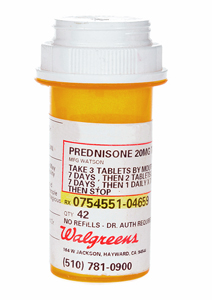Earlier this month, a new study created shockwaves in the media. According to the researchers, long-term use of benzodiazepines, prescribed for anxiety and sleep problems, and one of the most commonly prescribed drugs in use today, appears to be linked to an increased risk of developing Alzheimer’s disease. How this could be a surprise to anyone is beyond me. There is no surprise here. Over the years, we’ve repeatedly examined the connection between pharmaceutical drugs and dementia. For example, back in a 2008 newsletter, we recommended that you avoid common prescription drugs such as sleep aids, anti-anxiety drugs, antidepressants, allergy drugs, and even cold remedies, all of which were known to cause dementia as a side effect.
How much mental decline do these drugs account for?
According to most voices in the alternative health community, side effects from pharmaceutical drugs account for the vast majority of people “diagnosed” with dementia–possibly as high as 90%. Not surprisingly, the medical community believes that number is much smaller. Just five years ago, doctors felt that side effects from prescription drugs were responsible for only a minority of dementia cases; but even using their conservative numbers, such side effects from pharmaceutical drugs still were estimated to represent as many as 30% of all dementia diagnoses. So even according to conservative medical estimates, reducing prescription drugs could dramatically decrease your chances of suffering mental decline as you age. Dementia, incidentally, currently affects about 44 million people worldwide, and this number is expected to double every 20 years, reaching 135 million by 2050.1 “Dementia statistics.” Alzheimer’s Disease International. 2013. (Accessed 16 Sept 2014.) http://www.alz.co.uk/research/statistics Thus, any reduction would have a profound impact.
Now, just six years later, the two camps–alternative and traditional–seem to be converging in their estimates, and all the movement in that convergence is coming from the traditional camp. For example, a June 2014 study out of New Zealand concluded that given the evident harms associated with the use of antipsychotic and benzodiazepine medicines in the elderly, the prescribing of these medicines should be reassessed.2 Jackson G, Gerard C1, Minko N, Parsotam N. “Variation in benzodiazepine and antipsychotic use in people aged 65 years and over in New Zealand.” N Z Med J. 2014 Jun 20;127(1396):67-78. http://www.ncbi.nlm.nih.gov/pubmed/24997465
And it’s not just cognitive decline. Several other studies have found that when antipsychotics are used to treat older people who have been “diagnosed” with dementia and Alzheimer’s disease (and let’s not forget that this initial diagnosis may actually be caused by the pharmaceutical drugs these patients are already taking), they face an increased risk of death. In fact, the U.S. Food and Drug Administration (FDA) now mandates that drug makers add what is referred to as a “black box” warning to the labels of all antipsychotics, alerting doctors and patients to this increased mortality risk in people with dementia-related psychosis. For many patients this might be the ultimate Catch-22. You are prescribed medications which produce the symptoms of dementia in the first place; you are then prescribed antipsychotics to deal with these drug induced symptoms; you die as a result. Talk about getting it both coming and going!
In fact, it was in 2005 that the FDA first warned that clinical trial data strongly suggested that newer “atypical” antipsychotics increased the risk of death in dementia patients. As already mentioned, the agency then required these drugs to carry its strongest “black box” warning on their labels. In 2008, the FDA went further. Based on observational studies, they warned that even the older–previously considered safe–antipsychotics also seemed to increase dementia patients’ risk of death. All of these drugs now carry a black box warning. As Thomas Laughren, MD, director of the FDA division of psychiatry products at the time, said in a news conference, “We just don’t understand the mechanism, but there is an excess risk of mortality when these drugs are used for this indication.”3 “Antipsychotics Used For Dementia Can Increase Risk Of Death.” Doctone. June 17th, 2008. (Accessed 15 Sept 2014.) http://www.doctone.com/antipsychotics-used-for-dementia-can-increase-risk-of-death.html
So once again, how could anyone be surprised?
Let’s now explore that issue in some detail, and then conclude by taking another look at something we explored just last month–the names used to describe the different approaches to healing and medicine.
Anti-anxiety Medication and Alzheimer’s

The study, referred to above and which was published in the British Medical Journal, found that the long-term use of benzodiazepines could result in up to a 50 percent increased risk of developing Alzheimer’s.4 Sophie Billioti de Gage, Yola Moride, Thierry Ducruet, Tobias Kurth, et al. “Benzodiazepine use and risk of Alzheimer’s disease: case-control study.” BMJ 2014;349:g5205. http://www.bmj.com/content/349/bmj.g5205 Benzodiazepines are prescribed for their anxiolytic (anxiety reducing) and sedative properties and include well-known drugs such as Xanax, Ativan, and Valium. They are among the most commonly prescribed medications in the world today–especially among seniors. It helps keep them quiet in nursing homes.
The French-Canadian team of researchers found a cumulative dose-effect association between exposure to benzodiazepines (over 90 days) and the risk of developing Alzheimer’s. Specifically, they found that taking benzodiazepine for 90 days is linked to a 51% increased risk of dementia. But even worse, taking benzodiazepines for more than 180 days is associated with a doubling of that risk. And in some nursing homes, 180 days is nothing. In fact, you just might be on anti-anxiety medications permanently, until the day you die–which we now know is moved forward considerably if you’re on them…
The researchers studied a health database of adults ages 66 and over in Quebec (the RAMQ Quebec health insurance program database). Nearly 1,800 subjects were found to have Alzheimer’s, and nearly half had used benzodiazepines. Nearly one-in-three of these sufferers had long-term use (over six months) of the drugs. The researchers compared the Alzheimer’s group with a control group of people of the same age, without dementia. Just 40 percent of the control group had used benzodiazepines at some point and just under 22 percent were documented to have long-term use.
Although the researchers concluded that benzodiazepine use was associated with an increased risk of Alzheimer’s disease, they emphasized that the nature of the link is still not definitive but do admit that the stronger association seen with long-term exposures “reinforces the suspicion of a possible direct association, even if benzodiazepine use might also be an early marker of a condition associated with an increased risk of dementia.” Further, the strength of the association between benzodiazepine use and Alzheimer’s was shown to increase with longer-acting forms of the drug and also with extended exposure. Further, adjustment for symptoms that might indicate the start of dementia, such as anxiety, depression, or sleep disorders, did not meaningfully alter the results. The statistical correlation between benzodiazepines and Alzheimer’s was strong.
As previously stated, that these results could be surprising to anyone, is the only real surprise. Similar results have repeatedly been found in other studies. For example, a 2012 study in France, conducted by some of the same researchers, also found a 50 percent likelihood of dementia in older adults who had any exposure, ever, to such drugs.5 Sophie Billioti de Gage, Bernard Bégaud, Fabienne Bazin, Tobias Kurth, et al. “Benzodiazepine use and risk of dementia: prospective population based study.” BMJ 2012;345:e6231. http://www.bmj.com/content/345/bmj.e6231
The researchers concluded that their findings are of “major importance for public health, especially considering the prevalence and chronicity of benzodiazepine use in elderly populations and the high and increasing incidence of dementia in developed countries.”
In an accompanying editorial, Professor Kristine Yaffe of the University of California at San Francisco and Professor Malaz Boustani of the Indiana University Center for Aging Research, state, “It is not surprising that benzodiazepines are associated with adverse cognitive effects.”6 2.K. Yaffe, M. Boustani. Benzodiazepines and risk of Alzheimer’s disease. BMJ, 2014;349:g5312 . http://www.bmj.com/content/349/bmj.g5312 They point out that in 2012 the American Geriatrics Society updated its list of inappropriate drugs for older adults to include benzodiazepines, precisely because of their unwanted cognitive side effects. They then went on to point out, somewhat alarmingly, that almost 50% of older adults continue to use these drugs without any formal monitoring system. They suggest that this means the potential long term consequences on brain health are likely to be missed, adding to the growing prevalence of cognitive impairment among seniors.
Based on what we now know, that would seem to be a classic case of understatement.
Benzodiazepines are sold under the following brand names:
Alodorm, Alprox, Ansilan, Antenex, Anxon, Apaurin, Apozepam, Apzepam, Ativan, Bromam, Centrax, Clozan, Dadumir, Dalmadorm, Dalmane, Depas, Domar, Doral, Dormex, Dormicum, Dormonid, Dormonoct, Dumolid, Elenium, Erimin, Etilaam, Etizest, Euhypnos, Flunipam, Fluscand, Gerodorm, Halcion, Helex, Hexalid, Hipnosedon, Hypnovel, Iktorivil, Klonopin, Lectopam, Lendormin, Lexaurin, Lexotan, Lexotanil, Librium, Lorabenz, Loramet, Lorenin, Lorsilan, Lysanxia, Madar, Meilax, Mezapam, Mogadon, Myolastan, Nitrazadon, Nobrium, Noctamid, Noctilan, Normison, Olcadil, Onax, Opamox, Oxabenz, Oxapax, Pacisyn, Pasaden, Pax, Paxam, Paxipam, Phenazepam, Pronoctan, ProSom, Raporan, Restas, Restoril, Restyl, Rilamir, Risolid, Rivatril, Rivotril, Rize, Rohydorm, Rohypnol, Ronal, Ronlax, Rudotel, Sepazon, Serax, Serenid, Serepax, Seresta, Sintonal, Sobril, Stedon, Stesolid, Stilny, Tafil, Tavor, Temaze, Temesta, Tenox, Tranxene, Tranxilium, Valaxona, Valium, Veratran, Versed, Victan, Vival, Vulbegal, Xanax, Xanor
The sheer number of brands should give you a hint as to how widespread their use is–and, thus, how widespread the problem is. And if that’s all there were to the problem, it would be frightening enough. Unfortunately, benzodiazepines are just the tip of the proverbial iceberg.
Other Drugs that Cause Dementia and Related Symptoms
As we’ve learned, almost 50% of older adults use anti-anxiety drugs–without any formal monitoring. But benzodiazepines are just the tip of the proverbial iceberg. Other drugs known to degrade cognitive ability and create confusion (symptoms often misdiagnosed as dementia) include: antidepressants, antipsychotics, antihistamines, antiemetics (to relieve nausea), analgesics (for pain relief), and antiparkinsonian, antispasmodic, and urinary incontinence drugs7 Arvind Modawal. “Prescription Medication in the Elderly.” Net Wellness. 15 Dec 2000. (Accessed 18 Sep 2014.) http://netwellness.org/healthtopics/aging/faq16.cfm , 8 Shinohara M1, Yamada M. “Drug-induced cognitive impairment.” Brain Nerve. 2012 Dec;64(12):1405-10. http://www.ncbi.nlm.nih.gov/pubmed/23209067 –not to mention corticosteroids and sleeping medications, which can additionally cause side effects such as sleep walking and hallucinations, which also contribute to diagnoses of dementia.
Let’s take a look at some of these drugs.
Antidepressants
In 2011, the CDC reported that 11 percent of Americans over the age of 12 takes an antidepressant, with about 14 percent taking the medication for more than 10 years. And slightly over one-third of Americans ages 12 and over with current severe depressive symptoms are taking antidepressants.9 Laura A. Pratt, Debra J. Brody, and Qiuping Gu, M.D. “Antidepressant Use in Persons Aged 12 and Over: United States, 2005–2008.” NCHS Data Brief, No. 76, October 2011. http://www.cdc.gov/nchs/data/databriefs/db76.pdf What cognitive side effects are antidepressants associated with? In fact, memory loss, cognitive decline, and dementia are all reported side effects associated with antidepressants.10 “Drugs That May Cause Psychiatric Symptoms.” Publication: The Medical Letter on Drugs and Therapeutics. July 8, 2002. v44 59-62. http://secure.medicalletter.org/cannotaccess?ac=1&a=1134a&t=article&n=10051&p=tml&title=Drugs%20That%20May%20Cause%20Psychiatric%20Symptoms&i=1134 , 11 Kessing LV1, Søndergård L, Forman JL, Andersen PK. “Antidepressants and dementia.” J Affect Disord. 2009 Sep;117(1-2):24-9. http://www.ncbi.nlm.nih.gov/pubmed/19138799 , 12 Beers MH. “Explicit criteria for determining potentially inappropriate medication use by the elderly–an update.” Arch Intern Med. 1997;157:1531-1536. http://archinte.jamanetwork.com/article.aspx?articleid=623574 In other words, the use of antidepressants can lead to an eventual diagnosis of dementia.
Corticosteroids
 A 2011 study published in Psychiatry and Clinical Neurosciences found that corticosteroids such as prednisone are widely used in modern medicine but often result in troubling psychiatric side-effects including psychosis, mania, hypomania, depression, apathy, anxiety, panic, depersonalization, delirium, confusion, hallucinations, delusions, paranoia, cognitive impairment, and dementia.13 Kenna HA1, Poon AW, de los Angeles CP, Koran LM. “Psychiatric complications of treatment with corticosteroids: review with case report.” Psychiatry Clin Neurosci. 2011 Oct;65(6):549-60. http://www.ncbi.nlm.nih.gov/pubmed/22003987 The study identified fifty-five cases and a number of clinical trials investigating the incidence and treatment of these psychiatric symptoms and syndromes. The researchers concluded that the cumulative data indicate that psychiatric complications of corticosteroid treatment are not rare and range from clinically significant anxiety and insomnia, to severe mood and psychotic disorders, delirium, and dementia.
A 2011 study published in Psychiatry and Clinical Neurosciences found that corticosteroids such as prednisone are widely used in modern medicine but often result in troubling psychiatric side-effects including psychosis, mania, hypomania, depression, apathy, anxiety, panic, depersonalization, delirium, confusion, hallucinations, delusions, paranoia, cognitive impairment, and dementia.13 Kenna HA1, Poon AW, de los Angeles CP, Koran LM. “Psychiatric complications of treatment with corticosteroids: review with case report.” Psychiatry Clin Neurosci. 2011 Oct;65(6):549-60. http://www.ncbi.nlm.nih.gov/pubmed/22003987 The study identified fifty-five cases and a number of clinical trials investigating the incidence and treatment of these psychiatric symptoms and syndromes. The researchers concluded that the cumulative data indicate that psychiatric complications of corticosteroid treatment are not rare and range from clinically significant anxiety and insomnia, to severe mood and psychotic disorders, delirium, and dementia.
Although similar steroids are produced internally in the body, the man-made version is widely prescribed to reduce inflammation, allergic reactions, Crohn’s disease, ulcerative colitis, bronchitis, asthma, arthritis (both osteo and rheumatoid), skin disorders such as psoriasis, rectal itching, and lupus. Some commonly prescribed corticosteroids include cortisone, prednisone, and methylprednisolone. Prednisone is the most commonly used type of steroid to treat certain rheumatologic diseases.
The connection between this class of drugs and the psychiatric side-effects they produce is that corticosteroids appear to shrink/atrophy the part of the brain that controls cognition and memory: the hippocampus. fn] Y I Sheline, P W Wang, M H Gado, J G Csernansky, and M W Vannier. “Hippocampal atrophy in recurrent major depression.” Proc Natl Acad Sci U S A. Apr 30, 1996; 93(9): 3908–3913. http://www.ncbi.nlm.nih.gov/pmc/articles/PMC39458/pdf/pnas01516-0203.pdf [/fn], 14 Bremner JD1, Narayan M, Anderson ER, Staib LH, Miller HL, Charney DS. “Hippocampal volume reduction in major depression.” Am J Psychiatry. 2000 Jan;157(1):115-8. http://www.ncbi.nlm.nih.gov/pubmed/10618023 This particular part of the brain plays important roles in the consolidation of information from short-term memory to long-term memory and spatial navigation. It plays a fundamental role in learning, remembering, recognizing where you are, and in language. In Alzheimer’s disease, the hippocampus is one of the first regions of the brain to suffer damage, resulting in disorientation and memory loss. So again, how surprising can it be that a class of drugs that shrinks the part of the brain associated with memory, learning, and even emotional behavior can produce symptoms of cognitive decline and dementia?
And, of course, it’s not just dementia. Common side effects of systemic steroids include:
- Weight gain
- Sudden mood swings
- Muscle weakness
- Blurred vision
- Increased growth of body hair
- Easy bruising
- Lower resistance to infection
- Water retention and swelling, including a swollen, “puffy” face
- Acne
- Osteoporosis (bone weakening disease)
- Worsening of diabetes
- High blood pressure
- Stomach irritation
- Nervousness, restlessness
- Difficulty sleeping
- Cataracts and glaucoma
Antihistamines and Pain Killers
A 2007 study published in the Journal of the American Geriatric Society found that after controlling for age, education, baseline cognitive score, the use of anticholinergics (antispasmodics), and any history of diabetes mellitus and depression, the continuous use of H2As (antihistamines) was associated with a greater risk of incident cognitive impairment than for nonusers.15 Boustani M1, Hall KS, Lane KA, Aljadhey H, Gao S, et al. “The association between cognition and histamine-2 receptor antagonists in African Americans.” J Am Geriatr Soc. 2007 Aug;55(8):1248-53. http://www.ncbi.nlm.nih.gov/pmc/articles/PMC2860609/ And although the study has its limitations, its results are not out of line with several other studies.16 Hanlon JT1, Landerman LR, Artz MB, Gray SL, et al. “Histamine2 receptor antagonist use and decline in cognitive function among community dwelling elderly.” Pharmacoepidemiol Drug Saf. 2004 Nov;13(11):781-7. http://www.ncbi.nlm.nih.gov/pubmed/15386717 In fact, some studies have found that histamine actually plays a protective role in Alzheimer’s disease, which would mean that the regular use of antihistamines could easily play a promotional role.17 Naddafi F1, Mirshafiey A. “The neglected role of histamine in Alzheimer’s disease.” Am J Alzheimers Dis Other Demen. 2013 Jun;28(4):327-36. doi: 10.1177/1533317513488925. Epub 2013 May 15.
As for pain killers, there are several studies that make a connection between their use and the onset of dementia. For example, psychometric and psychiatric studies on eight patients who had abused compound analgesics containing phenacetin showed that four had definite evidence, and two possible evidence, of organic dementia. Neuropathological studies on nine other analgesic abusers disclosed a surprisingly high incidence of the histological features of Alzheimer’s disease. It is suggested that gross abuse of phenacetin may overwhelm the antioxidant protection of the body, leading to premature deposition of lipofuscin, and accelerated neuronal aging.18 R.M. Murray, J.G. Greene, J.H. Adams. “ANALGESIC ABUSE AND DEMENTIA.” The Lancet, Volume 298, Issue 7718, Pages 242 – 245, 31 July 1971. http://www.thelancet.com/journals/lancet/article/PIIS0140-6736(71)92576-1/abstract
But it’s not just studies that have found the connection between the use of pain killers and cognitive issues. The Merck Manual actually lists delirium as a possible side effect of the use of analgesics after surgery.19 “Delerium.” Merck Manual. July 2013. (Accessed 21 Sep 2014.) http://www.merckmanuals.com/home/brain_spinal_cord_and_nerve_disorders/delirium_and_dementia/delirium.html
Polypharmacy
 If you’re not disturbed by what you’ve read so far, hang on. It only gets worse. Keep in mind, we’ve only been talking about the side effects of taking one single drug in isolation. What happens when you take more than one drug and they interact with each other? Keep in mind that a 2013 Mayo Clinic study found that almost 70 percent of Americans are on at least one prescription drug, which by itself should scare the bejeebers out of you.20 Zhong, Wenjun et al. “Age and Sex Patterns of Drug Prescribing in a Defined American Population.” Mayo Clinic Proceedings , Volume 88 , Issue 7 , 697 – 707. http://www.mayoclinicproceedings.org/article/S0025-6196(13)00357-1/fulltext However, that same study found that more than half of all adults take two medications, and one in five patients are on five or more prescription medications. But hang on: we haven’t hit the really frightening numbers yet. According to a 2000 report commissioned by Families USA, a Washington based national non-profit group focused on healthcare:21 “COST OVERDOSE: Growth in Drug Spending for the Elderly, 1992 – 2010. Families USA. July 2000. (Accessed 20 Sep 2014.) http://lobby.la.psu.edu/_107th/101_Medicare_Rx_Coverage/Organizational_Statements/FamiliesUSA/FamiliesUSA
If you’re not disturbed by what you’ve read so far, hang on. It only gets worse. Keep in mind, we’ve only been talking about the side effects of taking one single drug in isolation. What happens when you take more than one drug and they interact with each other? Keep in mind that a 2013 Mayo Clinic study found that almost 70 percent of Americans are on at least one prescription drug, which by itself should scare the bejeebers out of you.20 Zhong, Wenjun et al. “Age and Sex Patterns of Drug Prescribing in a Defined American Population.” Mayo Clinic Proceedings , Volume 88 , Issue 7 , 697 – 707. http://www.mayoclinicproceedings.org/article/S0025-6196(13)00357-1/fulltext However, that same study found that more than half of all adults take two medications, and one in five patients are on five or more prescription medications. But hang on: we haven’t hit the really frightening numbers yet. According to a 2000 report commissioned by Families USA, a Washington based national non-profit group focused on healthcare:21 “COST OVERDOSE: Growth in Drug Spending for the Elderly, 1992 – 2010. Families USA. July 2000. (Accessed 20 Sep 2014.) http://lobby.la.psu.edu/_107th/101_Medicare_Rx_Coverage/Organizational_Statements/FamiliesUSA/FamiliesUSA
- The average number of prescriptions per elderly person grew from 19.6 in 1992 to 28.5 in 2000, an increase of 45 percent.
- The report also estimated that by 2010, the average number of prescriptions per elderly person was projected to grow to 38.5, an increase of 10 prescriptions, or 35 percent, per senior over 2000 levels.
Why is this so frightening?
Because any two drugs can interact with each other in ways not fully understood, producing entirely unexpected symptoms. Increase the number of drugs from two to 38.5 and the number and scope of possible side effects are beyond imagining. For decades, the medical community ignored this possibility, but ultimately was forced to acknowledge it and commit to studying it. In any event, this new area of study has gone little further than naming itself: polypharmacy. Technically, polypharmacy refers to the use of multiple medications by a patient, generally older adults over the age of 65. More specifically, it is often defined as the use of four or more regular medications. Concerns about polypharmacy include increased adverse drug reactions, drug-drug interactions, prescribing cascades, and higher costs. Curiously, studies have shown that the lower your education level, the more likely you are to be using multiple prescriptions.22 Haider SI, Johnell K, Weitoft GR, Thorslund M, Fastbom J (2009). “The influence of educational level on polypharmacy and inappropriate drug use: a register-based study of more than 600,000 older people.”.Journal of the American Geriatrics Society 57 (1): 62–69. http://www.ncbi.nlm.nih.gov/pubmed/19054196 Not surprisingly, then, polypharmacy is often associated with a decreased quality of life, decreased mobility, and decreased cognition.23 E.R. Hajjar et al. “Polypharmacy in Elderly Patients.” The American Journal of Geriatric Pharmacotherapy. Volume 5, Number 4, December 2007 345. http://www.vumc.nl/afdelingen-themas/41463/27797/2089686/2090096/1702335/2.pdf And based on what we’ve learned today, a dramatically increased risk of being diagnosed with dementia and dying prematurely. And yet, given the number of medications that seniors are routinely prescribed, it would seem that the medical community is incapable of following its own advice when it comes to polypharmacy: avoid it, and adhere to the adage “start low and go slow.”24 Moore AR1, O’Keeffe ST. “Drug-induced cognitive impairment in the elderly.” Drugs Aging. 1999 Jul;15(1):15-28. http://www.ncbi.nlm.nih.gov/pubmed/10459729
Anytime I Say Anything Bad About Psychopharmaceuticals
I always find it interesting that anytime I say anything negative about pharmaceutical drugs, and especially antidepressants and anti-anxiety medications, a lot of very angry people tend to write in. They tell me that I’m an idiot, that I don’t know what I’m talking about, that these drugs work, that they’ve saved their lives, and that if they had a chance, they’d do me serious bodily harm for spreading such lies. Maybe it’s just me, but I tend to think that the anger in their comments is somewhat indicative that perhaps these medications aren’t working quite as well as these people seem to think they are.
In any case, let me be very clear, I’m not saying that these drugs, or any drugs for that matter, should never be used. If nothing else works for you, then by all means give pharmaceutical drugs a try. But just keep in mind that antipsychotic drugs may not be all they’re cracked up to be. Studies have shown that, as a rule:
- Psychopharmaceuticals are not necessarily that effective. For example, exercise has proven more effective than antidepressants for relieving depression–and not just for minor depression, but for major depression. And in cases of bipolar depression, studies have shown that placebos are actually more effective than antidepressants.
- They come with a host of serious side effects, with dementia and death being two that we focused on today–not to mention a documented relationship between the use of antidepressants and violence toward “others”.
- And there may be natural options that work at least as well–remember, in many cases, all a natural option has to do is work as well as a placebo to accomplish that. And, more often than you have been led to believe, natural options may work even better than many pharmaceutical drugs and without the same level of harmful side effects.
Again, I’m not saying that all psychopharmaceuticals (let alone all pharmaceuticals) should be avoided. I’m just saying that perhaps they shouldn’t be your first option.
Which brings us back to the point I made at the top of this newsletter. As I mentioned, just last month, I talked about the importance of how we name the different branches of medicine. Western medicine likes to call itself “scientific” and “evidenced based”–which, by extension, implies that alternative medicine must be “unscientific” and “fantasy based.” In fact, according to Bob Carroll of the Skeptics Dictionary, “The entire benefit from CAM [complementary and alternative medicine] comes from the so-called placebo effect.”25 “Q. Why do you criticize “alternative” medicine only?” The Skeptic’s Dictionary. http://skepdic.com/faq.html#9 But it goes beyond that. Western medicine dislikes the term “alternative medicine” because it implies that it is a legitimate alternative. Instead, they prefer the term “complementary medicine” to indicate that it can never be used in place of Western medicine, but may complement it in some cases–not that it actually does anything useful, but it may have a placebo effect on the patients that makes them think they “feel” better about their treatments. In that newsletter, I suggested that “holistic” was a more accurate term to describe the type of medicine I advocate.
But now, based on yet another round of revelations about the limited effectiveness of the many pharmaceuticals that we’ve looked at today, as well as the severe side effects that accompany most of them, I’d like to offer a different set of naming options:
- What we call alternative, complementary, natural, and/or holistic medicine, could more accurately be described as: First Option Medicine. Unless you have a medical emergency in which the visible trauma is both the cause and effect of your predicament–think car crash or gunshot wound–then you might want to consider alternative medicine (make that First Option Medicine) as your first option. If you can eliminate diabetes or heart disease by changing your diet and incorporating the proper high-grade supplements with minimal side effects, why would you not?
- And what Western medicine likes to call scientific and evidenced based medicine could more accurately be described as: Last Resort Medicine. That is to say, when nothing else work or if you don’t have the willpower to follow the program (many people insist on the right to eat, drink, and smoke as they choose), then you should turn to modern medicine and its arsenal of surgical treatments and pharmaceutical drugs (along with all of their side effects) as the option of last resort.
And wouldn’t it be nice if your healthcare plan financially supported you in those choices. Just a guess, but it wouldn’t surprise me to see the cost of healthcare plunge like a rollercoaster hitting the goliath drop if enough people followed that model.

References
| ↑1 | “Dementia statistics.” Alzheimer’s Disease International. 2013. (Accessed 16 Sept 2014.) http://www.alz.co.uk/research/statistics |
|---|---|
| ↑2 | Jackson G, Gerard C1, Minko N, Parsotam N. “Variation in benzodiazepine and antipsychotic use in people aged 65 years and over in New Zealand.” N Z Med J. 2014 Jun 20;127(1396):67-78. http://www.ncbi.nlm.nih.gov/pubmed/24997465 |
| ↑3 | “Antipsychotics Used For Dementia Can Increase Risk Of Death.” Doctone. June 17th, 2008. (Accessed 15 Sept 2014.) http://www.doctone.com/antipsychotics-used-for-dementia-can-increase-risk-of-death.html |
| ↑4 | Sophie Billioti de Gage, Yola Moride, Thierry Ducruet, Tobias Kurth, et al. “Benzodiazepine use and risk of Alzheimer’s disease: case-control study.” BMJ 2014;349:g5205. http://www.bmj.com/content/349/bmj.g5205 |
| ↑5 | Sophie Billioti de Gage, Bernard Bégaud, Fabienne Bazin, Tobias Kurth, et al. “Benzodiazepine use and risk of dementia: prospective population based study.” BMJ 2012;345:e6231. http://www.bmj.com/content/345/bmj.e6231 |
| ↑6 | 2.K. Yaffe, M. Boustani. Benzodiazepines and risk of Alzheimer’s disease. BMJ, 2014;349:g5312 . http://www.bmj.com/content/349/bmj.g5312 |
| ↑7 | Arvind Modawal. “Prescription Medication in the Elderly.” Net Wellness. 15 Dec 2000. (Accessed 18 Sep 2014.) http://netwellness.org/healthtopics/aging/faq16.cfm |
| ↑8 | Shinohara M1, Yamada M. “Drug-induced cognitive impairment.” Brain Nerve. 2012 Dec;64(12):1405-10. http://www.ncbi.nlm.nih.gov/pubmed/23209067 |
| ↑9 | Laura A. Pratt, Debra J. Brody, and Qiuping Gu, M.D. “Antidepressant Use in Persons Aged 12 and Over: United States, 2005–2008.” NCHS Data Brief, No. 76, October 2011. http://www.cdc.gov/nchs/data/databriefs/db76.pdf |
| ↑10 | “Drugs That May Cause Psychiatric Symptoms.” Publication: The Medical Letter on Drugs and Therapeutics. July 8, 2002. v44 59-62. http://secure.medicalletter.org/cannotaccess?ac=1&a=1134a&t=article&n=10051&p=tml&title=Drugs%20That%20May%20Cause%20Psychiatric%20Symptoms&i=1134 |
| ↑11 | Kessing LV1, Søndergård L, Forman JL, Andersen PK. “Antidepressants and dementia.” J Affect Disord. 2009 Sep;117(1-2):24-9. http://www.ncbi.nlm.nih.gov/pubmed/19138799 |
| ↑12 | Beers MH. “Explicit criteria for determining potentially inappropriate medication use by the elderly–an update.” Arch Intern Med. 1997;157:1531-1536. http://archinte.jamanetwork.com/article.aspx?articleid=623574 |
| ↑13 | Kenna HA1, Poon AW, de los Angeles CP, Koran LM. “Psychiatric complications of treatment with corticosteroids: review with case report.” Psychiatry Clin Neurosci. 2011 Oct;65(6):549-60. http://www.ncbi.nlm.nih.gov/pubmed/22003987 |
| ↑14 | Bremner JD1, Narayan M, Anderson ER, Staib LH, Miller HL, Charney DS. “Hippocampal volume reduction in major depression.” Am J Psychiatry. 2000 Jan;157(1):115-8. http://www.ncbi.nlm.nih.gov/pubmed/10618023 |
| ↑15 | Boustani M1, Hall KS, Lane KA, Aljadhey H, Gao S, et al. “The association between cognition and histamine-2 receptor antagonists in African Americans.” J Am Geriatr Soc. 2007 Aug;55(8):1248-53. http://www.ncbi.nlm.nih.gov/pmc/articles/PMC2860609/ |
| ↑16 | Hanlon JT1, Landerman LR, Artz MB, Gray SL, et al. “Histamine2 receptor antagonist use and decline in cognitive function among community dwelling elderly.” Pharmacoepidemiol Drug Saf. 2004 Nov;13(11):781-7. http://www.ncbi.nlm.nih.gov/pubmed/15386717 |
| ↑17 | Naddafi F1, Mirshafiey A. “The neglected role of histamine in Alzheimer’s disease.” Am J Alzheimers Dis Other Demen. 2013 Jun;28(4):327-36. doi: 10.1177/1533317513488925. Epub 2013 May 15. |
| ↑18 | R.M. Murray, J.G. Greene, J.H. Adams. “ANALGESIC ABUSE AND DEMENTIA.” The Lancet, Volume 298, Issue 7718, Pages 242 – 245, 31 July 1971. http://www.thelancet.com/journals/lancet/article/PIIS0140-6736(71)92576-1/abstract |
| ↑19 | “Delerium.” Merck Manual. July 2013. (Accessed 21 Sep 2014.) http://www.merckmanuals.com/home/brain_spinal_cord_and_nerve_disorders/delirium_and_dementia/delirium.html |
| ↑20 | Zhong, Wenjun et al. “Age and Sex Patterns of Drug Prescribing in a Defined American Population.” Mayo Clinic Proceedings , Volume 88 , Issue 7 , 697 – 707. http://www.mayoclinicproceedings.org/article/S0025-6196(13)00357-1/fulltext |
| ↑21 | “COST OVERDOSE: Growth in Drug Spending for the Elderly, 1992 – 2010. Families USA. July 2000. (Accessed 20 Sep 2014.) http://lobby.la.psu.edu/_107th/101_Medicare_Rx_Coverage/Organizational_Statements/FamiliesUSA/FamiliesUSA |
| ↑22 | Haider SI, Johnell K, Weitoft GR, Thorslund M, Fastbom J (2009). “The influence of educational level on polypharmacy and inappropriate drug use: a register-based study of more than 600,000 older people.”.Journal of the American Geriatrics Society 57 (1): 62–69. http://www.ncbi.nlm.nih.gov/pubmed/19054196 |
| ↑23 | E.R. Hajjar et al. “Polypharmacy in Elderly Patients.” The American Journal of Geriatric Pharmacotherapy. Volume 5, Number 4, December 2007 345. http://www.vumc.nl/afdelingen-themas/41463/27797/2089686/2090096/1702335/2.pdf |
| ↑24 | Moore AR1, O’Keeffe ST. “Drug-induced cognitive impairment in the elderly.” Drugs Aging. 1999 Jul;15(1):15-28. http://www.ncbi.nlm.nih.gov/pubmed/10459729 |
| ↑25 | “Q. Why do you criticize “alternative” medicine only?” The Skeptic’s Dictionary. http://skepdic.com/faq.html#9 |












I am fortunate in that I don
I am fortunate in that I don’t take any prescription drugs at all.
I do my best to avoid prescription drugs of any kind now and mainly have succeeded.
I did recognize at least 4 you listed that I have taken in the past, though. What I remember now is it was for short term use.
My personal feeling is that many of the illnesses we have are caused by these drugs. Peoplespharmacy.com has numerous reports of problems people have experienced with different drugs. They also detail numerous alternative remedies as alternatives. I love their articles.
I always thought that
I always thought that “alternative, complemtary, holistic… whatever, should always be first choice. Why? Simply because of the side effects, adverse reactions from pharmaceuticals. Why would anyone take a pharmaceutical for a minor problem that could possibly kill you? I don’t get it. If it’s advertised that the drug can possibly have a fatal reaction that means someone actually died during drug trials. That also means that you can also. Maybe the percentages are against a fatal reaction or even a dangerous adverse reaction but the possibility exists. It’s like Russian roulette! I’m sure doctors are always saying that these reactions are very rare but how do they know who the rare person is? Unless someone is in a crisis where there is little choice I don’t understand why anyone would start with a pharmaceutical.
John, I am so tired of
John, I am so tired of hearing about how important it is that we get off these medications but no one has suggestions on how we detox and if there are treatment centers to go to. I have been taking these drugs for over 20 years, and I do not believe it is safe for me to go off of them without being monitored medically. But I am not a prescription drug addict or an alcoholic or an abuser of illegal drugs. Nor do I have other behavioral problems- please address where the many like myself go for help and support to move to only nutraceuticals and natural ways to handle anxiety, and depression.
Find a doctor who is willing
Find a doctor who is willing to work with you and monitor you as you explore alternatives to see if you can wean yourself off medications.
Jon, unfortunately, there are
Jon, unfortunately, there are no doctors in my area that are holistic, or natural. (If there were, they wouldn’t be on my insurance.) And the ones I’ve had all push the importance of not getting off my antidepressants! (It’s like they all get paid to keep me on lots of drugs. They seem to consider anything else nonsense.) If I stop taking antihistamines, I get itchy blotches all over.
BTW…I think the people that get angry are mostly just terrified of what they’ll do or become without antidepressants. It’s so scary to remember what I’m like and how I feel without them.
I love your supplements and would love to have therapeutic doses, but I just cannot afford them.
Leigh, look up ACAM. They
Leigh, look up ACAM. They list physicians who are dually trained. Andrew Weil, MD, has a site, perhaps they can send you to someone in your area. You can also google alternative medicine MDs or ODs. Or, look up in your area naturopathic or other alternative medicine practitioners and ask them who they would refer patients to.
Good advice but that should
Good advice but that should be DO not OD.
Thank you for the very
Thank you for the very interesting and informative article. I don’t use prescription drugs at all unless there is an emergency. Both of my parents died from Alzheimer’s and they were taking a lot of these prescription drugs daily. I truly feel that there’s more to what we can fully understand with the big pharma battle.
Where did the notion come
Where did the notion come from adverse reactions are rare?
800,000 people are known to have died in Europe due to being prescribed a heart medication protocol incorrectly prior to surgery in a five year period.
Ken B
Jon,
Jon,
I have been a reader of your articles for a long time. I have listened to you podcasts too. I really believe in what you say. Your use of empirical evidence the back up your claims is refreshing.
But I feel trapped. I have had a history of mental ailments like severe depression as well as being just recently diagnosed as bipolar.
The anguish and pain I have experienced and inflicted on others during my lifetime is something I would not wish on my worst enemy. I have only resorted to pharmaceuticals recently. Why? No amount of diet or anything else has helped my mental issues. It scares the crap out of me what the potential, and guaranteed according to your article, side effects I will succumb to. I seem to be making every effort to become someone I am not.
Now please, those who are reading this, don’t tell me that I just need to snap out of it or man up and deal with it. I’m 52 years old. I have tried all that I know to overcome this without pills. Einstein’s idiom of repeating something over and over hoping for a different outcome has been my experience. At some point one must be open to “alternative” ways of dealing with a life-long debilitating illness (yes I choose the word alternative purposely, fully aware of my inverted meaning given this websites raison d’etre) .
Statistically speaking we are all very much snowflakes, where no two are alike. Nature/nurture, it doesn’t matter. Genetic roulette is very much a factor for all of us. We can only hope to lessen the bad cards we are dealt, and maximize the good ones.
My long-winded question is: Is it not possible that ones homeostasis be adversely affected by this notion of genetic roulette and that at least in my case most if not all holistic methods have proven unsatisfactory?
PS> I don’t make a lot of money and consequently, good food and good doctors are for the most part beyond my reach. I have been a vegetarian since 2009 and exercise most days.
Thanks for the good work you do and the knowledge you share.
Mike
Hi MIke,
Hi MIke,
I think Jon’s key point is that the drugs should not be your first option. He adds, “In any case, let me be very clear, I’m not saying that these drugs, or any drugs for that matter, should never be used. If nothing else works for you, then by all means give pharmaceutical drugs a try. But just keep in mind that antipsychotic drugs may not be all they’re cracked up to be.”
I HATE reading your articles.
I HATE reading your articles. I just want to say that up front. Why? Because, like this one in particular, the wealth of information you provide makes me ANGRY, which, in turn may require drugs, which, in turn, will likely cause Alzheimer’s! AND most of my family thinks I’m crazy anyway so I just sit here and worry about them because they won’t listen..which upsets me..which…well…NEVER MIND. You keep writing, I’ll keep reading and staying mentally alert for another 30 years (I’m 65) just to agrivate everyone!!!!!!!!!! Thanks Jon for all you do to help us navigate through the minefields!
Hi Linda,
Hi Linda,
We understand! Thanks for sharing.
That is a staggering number
That is a staggering number of prescription drugs! I am 65 and have never been on any. My mother-in-law is 94 and takes 3 counting synthroid.
Jon, I’m sure you read the LE article about Dr. Huizenga. At his clinic patients were off ALL meds after six weeks of exercise and diet.
My 90+ year old friend died
My 90+ year old friend died in a nursing home from the polypharmacy of forced “chemical straight-jacketing”. As such, he was abused to death.
Have you ever been through a
Have you ever been through a major depressive disorder
which is genetic? Have you ever had a major anxiety disorder?What medicines do you recommend that are as effective?
We have a lot of information
We have a lot of information about natural remedies on our site, just do a search on depression to see a list of articles. Also, I would reread the last part of this article, especially this section that links to more info:
“In any case, let me be very clear, I’m not saying that these drugs, or any drugs for that matter, should never be used. If nothing else works for you, then by all means give pharmaceutical drugs a try. But just keep in mind that antipsychotic drugs may not be all they’re cracked up to be. Studies have shown that, as a rule:
Again, I’m not saying that all psychopharmaceuticals (let alone all pharmaceuticals) should be avoided. I’m just saying that perhaps they shouldn’t be your first option.
I love these articles and I
I love these articles and I take one pharma drug prn, not as prescribed. That is hydrochlortjiazide, a diuretic. I take it one time per week at most. I truly believe Alzheimer’s and dementia are caused by pharma. Also, at age 77, I refuse to do med testing or follow bogus BP and other so-called guidelines issued by mainstream MDs.
Avoid doctors like the plague!